
Roots
To stand before the radiant crown of textured hair is to gaze upon a living archive, a chronicle etched in each curl, coil, and wave. Within this profound legacy, the meaning of heat styling for Black hair is not a singular, static truth, but a vibrant narrative woven through generations, echoing from ancient hearths to modern-day salons. It is a story of adaptation, aspiration, and identity, deeply rooted in the very biology of the strand and the ancestral wisdom that has long guided its care.
The exploration of heat’s influence upon these unique hair structures unearths layers of cultural significance, revealing how this practice, often viewed through a contemporary lens, carries the weight and beauty of a storied past. It is a dialogue between the elemental forces of warmth and the inherent resilience of hair, a conversation that has shaped traditions and defined expressions of self across the diaspora.

The Hair Follicle’s Ancient Blueprint
At the heart of textured hair’s distinct character lies its anatomical architecture, a marvel of biological design. Unlike straight hair, which often possesses a round cross-section, the follicular structure of coily and kinky hair tends to be elliptical or flattened, creating a helical growth pattern. This shape, alongside variations in keratin protein distribution and disulfide bonds, gives rise to the remarkable spring and volume so characteristic of Black hair. The journey of understanding heat’s interaction with this unique biology begins here, with the fundamental composition of the hair shaft itself.
Early communities, without the benefit of modern microscopy, understood this inherent difference through observation and tactile knowledge, developing practices that acknowledged the hair’s natural inclination and its response to environmental elements, including warmth from fire or sun. The way hair naturally spirals creates points of weakness along the shaft where the cuticle layer is more exposed, making it susceptible to moisture loss and breakage. This inherent fragility, understood through generations of lived experience, often informed the cautious application of heat in traditional settings.
Consider the Cortical Cells, the elongated structures that make up the bulk of the hair’s inner core. In textured hair, these cells are arranged unevenly, contributing to the hair’s helical twist. When heat is applied, particularly direct, high heat, the water within these cells rapidly expands, and the keratin proteins undergo a temporary structural change. This alteration, a denaturing process, allows the hair to be reshaped.
For centuries, ancestral communities observed how warmth could soften hair, making it more pliable for intricate braiding or detangling. This intuitive understanding of heat’s transformative capacity, though lacking scientific terminology, formed the basis of many traditional styling and care practices.

Beyond Numbers, A Spectrum of Lineage
Modern classification systems, often categorizing hair by curl pattern (e.g. 3C, 4A, 4B, 4C), serve as a useful lexicon for contemporary discourse. However, these systems, while offering a framework for understanding, do not fully encompass the profound diversity and cultural meaning embedded within textured hair.
Ancestral understandings of hair were far more holistic, often connecting hair type to lineage, geographic origin, and even spiritual significance. The way hair behaved under various conditions – humidity, dryness, or the application of warmth – was observed and passed down through oral traditions, becoming part of a collective heritage of hair knowledge.
The inherent structure of textured hair, with its unique follicular shape and protein arrangement, profoundly shapes its response to heat, a phenomenon observed and understood through generations of ancestral practice.
The very concept of “hair type” in these historical contexts was less about a numerical grade and more about a living, breathing aspect of one’s identity and connection to community. The practices surrounding hair, including any application of warmth, were not merely cosmetic but often ritualistic, tied to rites of passage, social status, or spiritual ceremonies. The understanding of hair was deeply personal, yet communally shared, reflecting a nuanced appreciation for the spectrum of textures that define Black hair heritage.
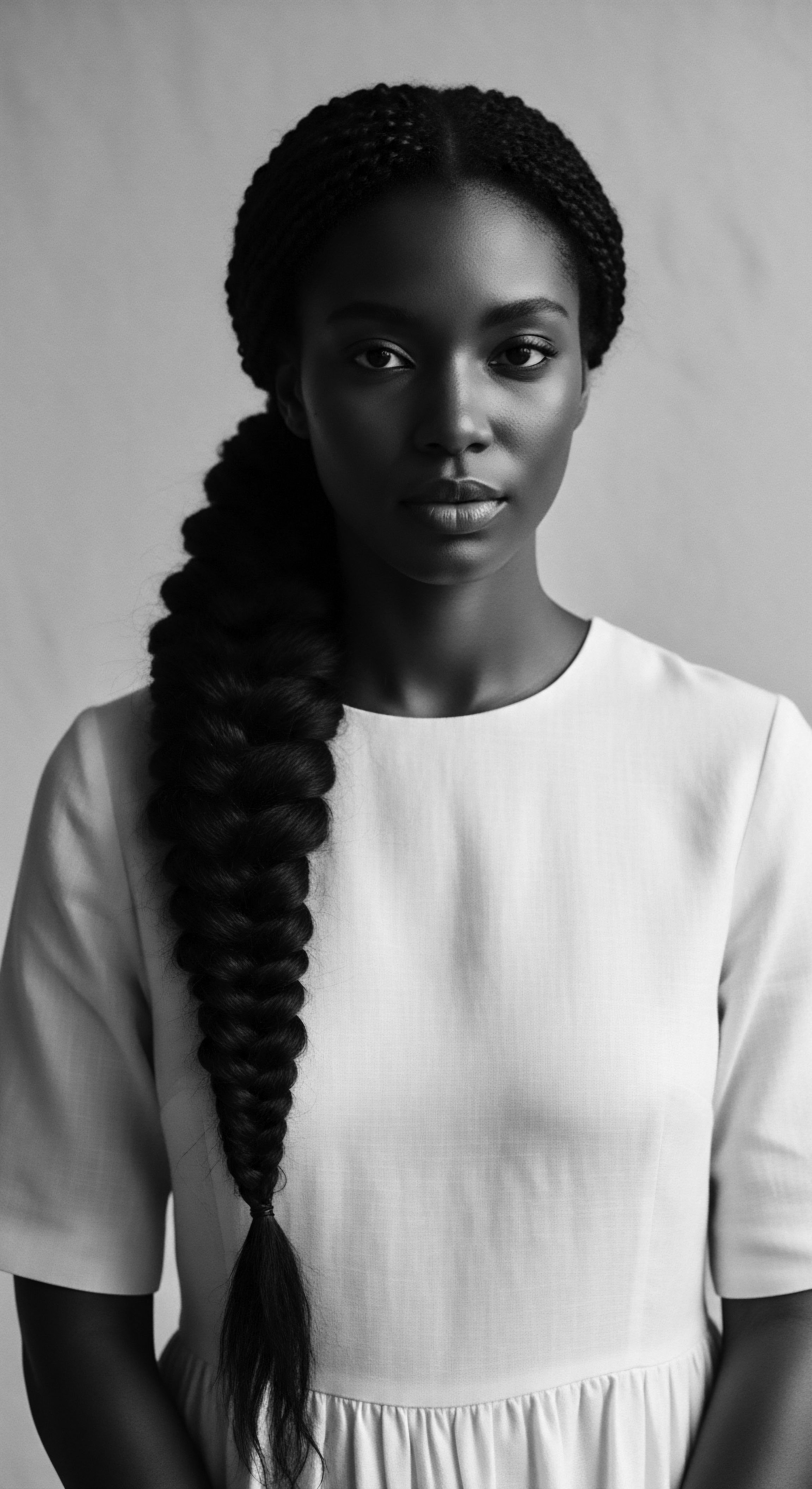
Words That Carry Ancestral Whispers
The language used to describe textured hair and its care has evolved, yet many terms carry the echoes of ancestral wisdom. While modern terms like “blowout” or “silk press” describe specific heat styling techniques, older practices might have used descriptive phrases that spoke to the feeling or outcome of the process. The “pressing comb,” for example, became a ubiquitous tool, and the act of “getting one’s hair pressed” was a phrase laden with cultural significance, often implying a preparation for special occasions or a presentation of respectability.
- Hot Comb ❉ A metal comb heated on a stove or burner, used to straighten or smooth hair. Its very name conjures images of communal kitchens and shared styling sessions.
- Hair Pressing ❉ The application of heat and tension to straighten coiled or kinky hair, a practice with a long lineage in Black communities.
- Thermal Straightening ❉ A broader term for using heat to temporarily alter the hair’s structure, encompassing various tools and techniques.
These terms, whether ancient or more recent, form a vital part of the lexicon of textured hair heritage. They are not just descriptors but signifiers of shared experiences, traditions, and the enduring journey of Black hair through time.

Cycles of Growth, Echoes of Environment
Hair growth cycles – anagen, catagen, and telogen – are universal, yet their expression and the health of the hair can be profoundly influenced by environmental factors, nutrition, and care practices passed down through generations. Ancestral diets rich in vitamins and minerals, often derived from nutrient-dense foods native to specific regions, played a foundational role in supporting hair health. Traditional hair oils and herbal infusions, often warmed to enhance their efficacy, were applied not just for styling but to nourish the scalp and strands, promoting vitality from the root.
The relationship between heat styling and these natural cycles is complex. While heat can temporarily alter the hair’s appearance, its consistent or improper application can disrupt the delicate balance of the hair follicle, potentially leading to damage that affects future growth. Historical practices, often relying on less intense, indirect heat, aimed to work with the hair’s natural rhythms, seeking to enhance its beauty without compromising its inherent strength. This awareness, though not codified in scientific papers, was a practical wisdom, a living testament to the ancestral understanding of holistic hair care.
The sun, a primal source of warmth, was often utilized to dry hair after washing, and in some cultures, specific stones or tools might have been warmed to aid in the application of emollients or to help shape styles. This subtle use of heat, integrated into daily life, speaks to a heritage where warmth was a natural element in the care regimen, rather than a forceful agent of transformation.

Ritual
As the narrative of textured hair unfolds, we move from its foundational biology to the living traditions that have shaped its expression. The ‘Ritual’ of hair care and styling, particularly where heat is involved, is not merely a set of actions but a deeply embedded cultural practice, a testament to ingenuity, community, and the persistent desire for self-expression. For those who wear textured hair, the evolution of heat styling tools and techniques mirrors a larger societal dialogue, reflecting aspirations, adaptations, and the enduring legacy of ancestral knowledge. Stepping into this realm is to acknowledge the practical applications of warmth, from the subtle softening of strands for braiding to the transformative power of the pressing comb, all within a continuum of shared experience and inherited wisdom.

The Warm Touch of Transformation
Heat styling, in its earliest forms, was often a gentle persuasion rather than a forceful imposition. Before the advent of modern electrical tools, communities utilized natural heat sources. Stones warmed by fire, heated metal combs, or even the sun’s direct rays were employed to aid in the manipulation of hair. These methods were frequently part of larger grooming rituals, often communal affairs where knowledge was exchanged, stories shared, and bonds strengthened.
The objective was not always complete straightening but often to soften the hair, making it more manageable for detangling, braiding, or setting into intricate designs. This historical application of heat was frequently intertwined with the application of natural oils and butters, creating a protective barrier and imparting a luminous finish. The act of warming these natural emollients on the stove or between the palms before applying them to the hair was a small, yet significant, act of care, a preparatory step that softened the strands and made them more receptive to styling.
Consider the ancestral practice of using warmed shea butter or palm oil. These rich, nourishing substances, when gently heated, became more pliable, allowing for easier distribution through dense coils. This was not just about aesthetics; it was about maintaining hair health, preventing breakage, and protecting the scalp. The warmth facilitated deeper penetration of these beneficial ingredients, a practical application of understanding that transcended mere styling.

Pressing Combs and the Art of Smoothing
The introduction of the hot comb, or pressing comb, marked a significant turning point in the history of Black hair styling. While its origins are debated, its widespread adoption in the late 19th and early 20th centuries fundamentally altered the landscape of Black hair expression. The hot comb, a metal tool heated on a stove, allowed for a more significant and lasting straightening effect than previous methods.
This tool became a cornerstone of hair care for many Black women, offering a means to achieve styles that aligned with prevailing beauty standards, which often favored straight hair. The ritual of the “press” was often a multi-step process, beginning with thorough washing, drying, and then the careful application of heat protectants (often natural oils) before the heated comb was drawn through sections of hair.
| Historical Method Warmed Stones for Softening |
| Modern Parallel Steam Treatments for Hair Elasticity |
| Historical Method Heated Metal Combs (Stove-top) |
| Modern Parallel Electric Hot Combs and Flat Irons |
| Historical Method Sun-drying and Shaping |
| Modern Parallel Diffusers for Controlled Drying |
| Historical Method The journey of heat in Black hair care reflects a continuous quest for both malleability and aesthetic expression, adapting ancestral ingenuity to contemporary tools. |
The “press” was not just a styling technique; it was a cultural phenomenon. It was a skill passed down from mothers to daughters, from aunties to nieces, often taking place in the intimate settings of kitchens or living rooms. These were spaces of storytelling, shared laughter, and sometimes, the quiet resilience forged in the face of societal pressures.
The mastery of the pressing comb was a point of pride, a skill that allowed for versatility and a sense of polished presentation. This practice, while sometimes controversial due to its association with assimilation, also represented a form of agency, allowing individuals to adapt and express themselves within the constraints of their environment.
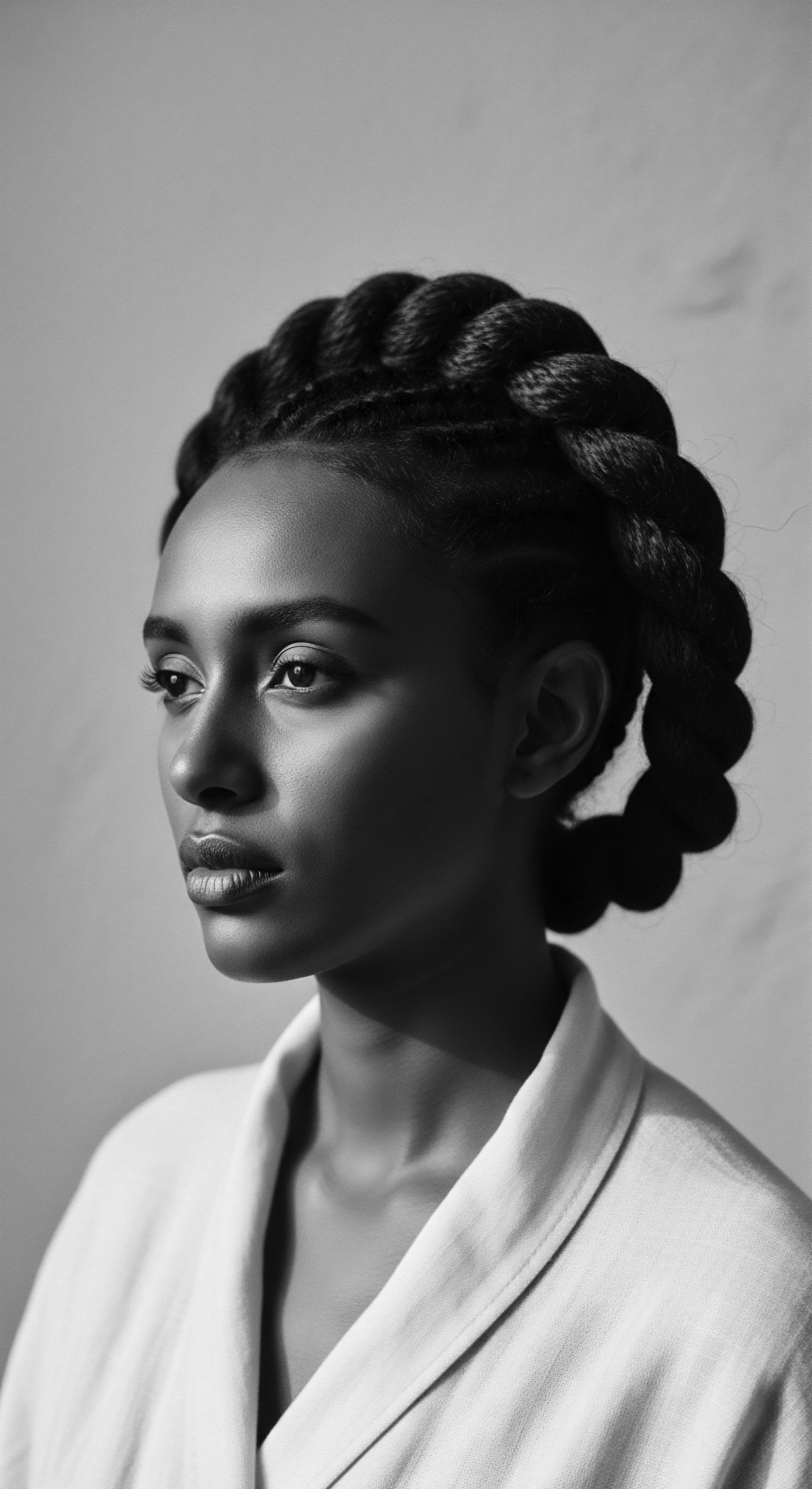
From Coil to Cascade, A Gentle Warmth
While many natural styling techniques emphasize air drying or non-heat methods, even within these traditions, a gentle warmth might have been employed. For instance, drying hair in the sun after a wash, or using warm cloths to aid in the setting of twists or braids, are subtle applications of heat that enhance definition and promote faster drying. These practices, less about radical transformation and more about enhancing the hair’s inherent beauty, speak to a deep understanding of textured hair’s needs. The careful manipulation of hair while slightly warm, perhaps after a warm rinse, can help to elongate coils or encourage a smoother set, a practice rooted in the practical observation of hair’s response to temperature.
The goal here was often to achieve a desired texture or shape without compromising the hair’s integrity. It was about working with the hair, rather than against it, a principle that echoes the holistic wellness advocacy inherent in Roothea’s ethos. The knowledge of how different levels of warmth affected hair, from gentle drying to more direct smoothing, was part of the shared wisdom of hair care, a heritage passed through tactile demonstration and patient instruction.

Adornment and Ancestral Craft
The history of wigs and hair extensions in Black cultures is as ancient as it is diverse, spanning continents and millennia. From the elaborate coiffures of ancient Egypt, often involving added hair, to the protective and decorative extensions found in various African societies, the manipulation of hair for adornment and status has a long and revered lineage. Heat played a role in the creation and maintenance of some of these extensions.
For example, animal hair or plant fibers used in traditional extensions might have been warmed to make them more pliable for braiding or twisting into existing hair. In later periods, particularly with the rise of human hair extensions, heat was and still is used in the processing of the hair itself to achieve desired textures or colors, or during installation to create a seamless blend.
The cultural meaning here extends beyond mere aesthetics; it speaks to a heritage of creativity, innovation, and self-presentation. Wigs and extensions allowed for versatility, protection, and the expression of identity, sometimes signifying marital status, age, or social standing. The application of heat in these contexts was a technical skill, a part of the artisan’s craft, enabling the creation of intricate and enduring styles that were both beautiful and culturally significant.

The Iron’s Song, A Legacy of Style
The thermal reconditioning of textured hair, particularly through the use of flat irons and blow dryers, represents a more modern chapter in the story of heat styling. While these tools offer efficiency and a high degree of straightening, their cultural meaning remains complex. For many, they represent a continuation of the desire for versatility and the ability to conform to broader beauty standards. For others, they symbolize a departure from natural texture, sometimes associated with societal pressures or a perceived need for “professional” appearance.
The ritual of heat styling, from ancestral warming practices to the modern pressing comb, represents a continuous dialogue between tradition, innovation, and the enduring cultural significance of hair.
Yet, even with modern tools, the underlying principle remains the same ❉ the temporary alteration of the hair’s hydrogen bonds through heat, allowing for reshaping. The cultural context of these tools is deeply intertwined with the history of Black women navigating public and professional spaces. The ability to present a straightened hairstyle often provided a sense of acceptance or ease in environments that did not always celebrate natural Black hair.
This is not to say that heat styling is solely a response to external pressure; for many, it is simply a choice, an aesthetic preference, or a means of expression within the vast spectrum of Black hair artistry. The understanding of how these tools interact with the hair’s delicate structure, and the importance of protective measures, is a contemporary extension of the ancestral wisdom of care.
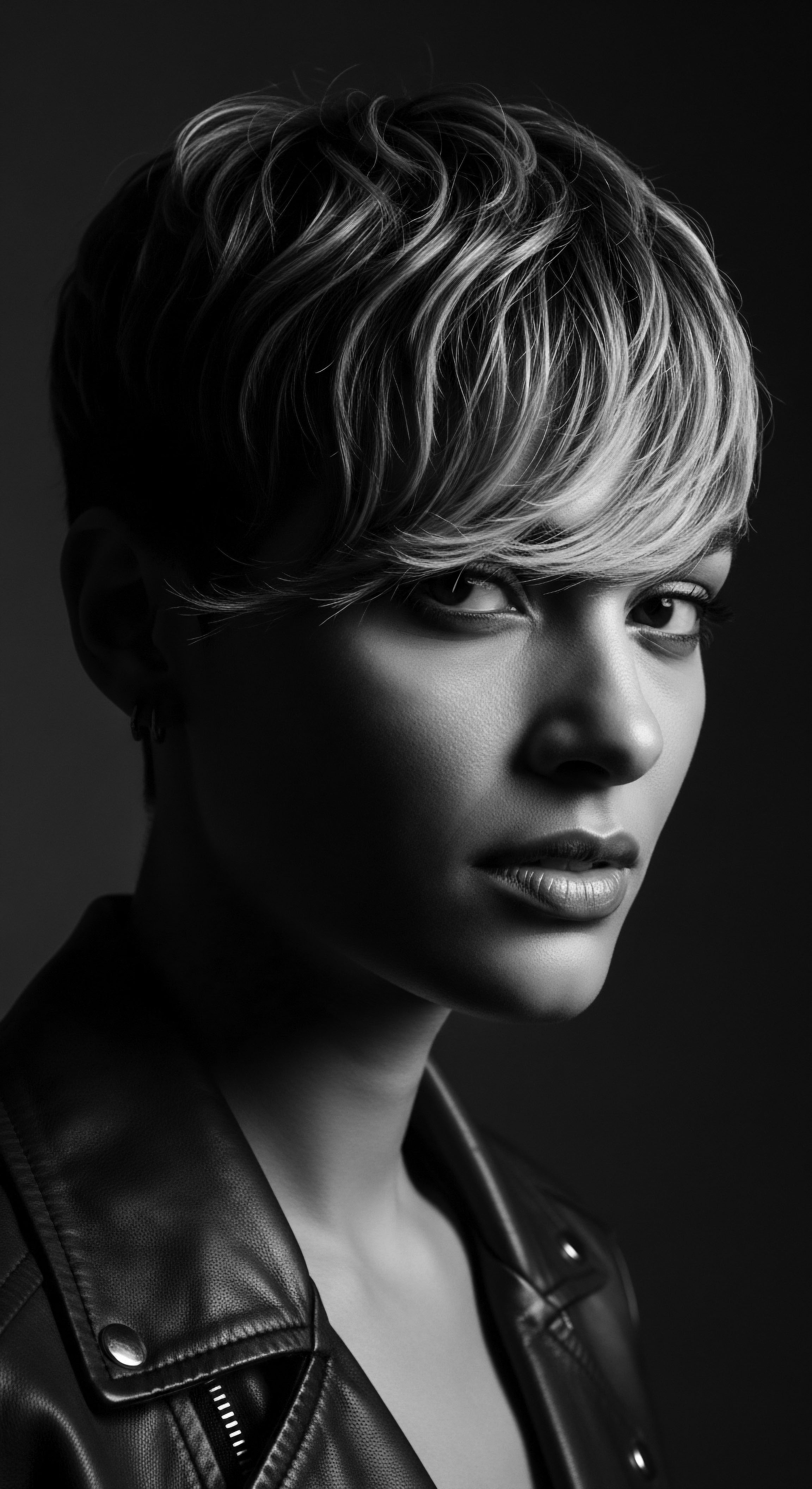
Instruments of Care and Adornment
The toolkit for textured hair, particularly for heat styling, has undergone a significant transformation. From the simple metal combs heated over open flames, we now have a diverse array of electrically powered devices.
- Traditional Pressing Combs ❉ Heated manually, requiring skill in temperature control and application.
- Electric Hot Combs ❉ Offer more consistent heat, making the process more accessible and safer when used correctly.
- Blow Dryers with Attachments ❉ Especially those with comb or diffuser attachments, allow for drying and stretching without direct contact.
- Flat Irons ❉ Modern ceramic or tourmaline plates offer even heat distribution for straightening.
Each of these tools, whether ancient or modern, carries a cultural resonance. They are not just implements but extensions of a legacy of care, creativity, and adaptation. The choice of tool, the technique employed, and the resulting style all contribute to the rich tapestry of Black hair heritage, where heat styling holds a prominent, albeit evolving, place. The reverence for these tools, and the knowledge of how to use them safely and effectively, is part of the ongoing transmission of hair wisdom through generations.
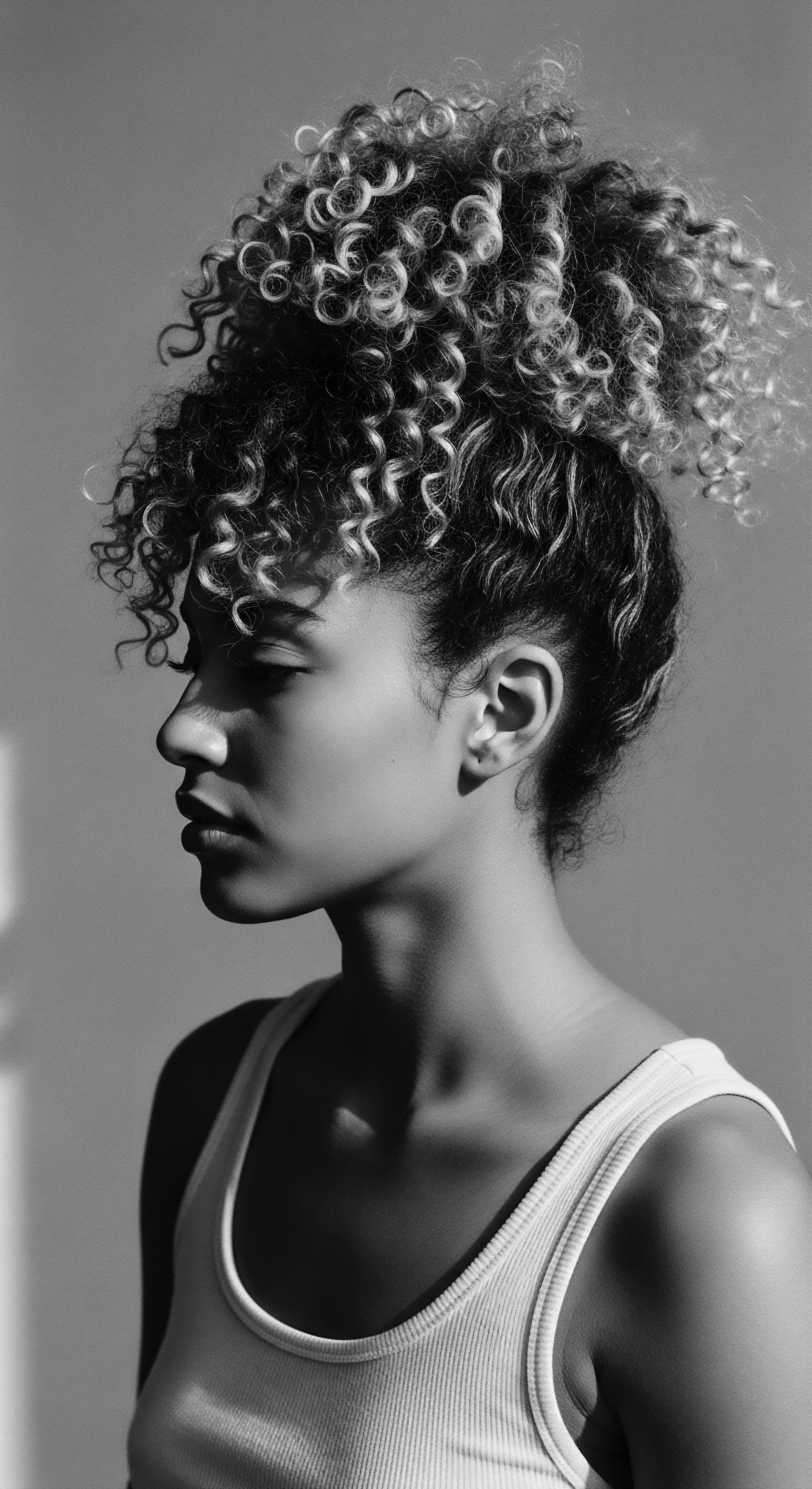
Relay
The journey of textured hair is a profound relay of meaning, passing from one generation to the next, carrying within its strands the stories of adaptation, resistance, and identity. As we delve into the cultural meaning of heat styling, we transcend mere technique to explore how this practice has shaped narratives, influenced self-perception, and mirrored societal shifts. The intricate dance between the hair’s natural form and its thermally altered state reveals a complex interplay of biological realities, social pressures, and individual expressions of autonomy.
This exploration invites us to consider the less apparent complexities, the unspoken dialogues that heat styling has facilitated, and its enduring role in the ongoing evolution of Black hair traditions. It is a space where science, cultural memory, and the intricate details of personal choice converge, offering a profound understanding of what it means to wear one’s heritage.

The Politics of Appearance
The cultural meaning of heat styling in Black hair heritage cannot be fully understood without acknowledging the historical context of systemic racism and the imposition of Eurocentric beauty standards. For centuries, particularly in Western societies, straight hair was often presented as the ideal, a marker of professionalism, respectability, and even intelligence. This pervasive societal pressure led many Black individuals to straighten their hair, often through rigorous and sometimes damaging heat styling methods, as a means of survival, acceptance, or advancement in a world that often devalued their natural texture. The act of straightening, while a personal choice, was frequently framed within a larger societal expectation, making it a practice imbued with complex socio-political implications.
This phenomenon is not merely historical; its echoes persist. Even today, discussions around “professional hair” often subtly or overtly lean towards straightened styles in certain corporate or institutional environments. The pressure to conform, though perhaps less overt than in past eras, still influences styling choices. However, the meaning is also shifting.
For some, heat styling is now a deliberate act of versatility, a conscious choice to present a different aesthetic without shedding their connection to their natural texture. It is a testament to the resilience and adaptability of Black hair culture that practices born from necessity have evolved to encompass a broader spectrum of personal expression.

A Shield, A Statement, A Surrender
The act of heat styling has served multiple, often contradictory, purposes within Black communities. For some, it was a protective shield, a way to navigate a world that often judged and marginalized natural Black hair. By straightening their hair, individuals could blend in, avoid discrimination, and secure opportunities that might otherwise be denied.
This was not a surrender of identity but a strategic adaptation, a pragmatic response to harsh realities. The hair became a canvas for negotiation, a subtle yet powerful tool in the struggle for dignity and survival.
Heat styling in Black hair heritage carries a complex legacy, serving as both a strategic adaptation to societal pressures and a vibrant avenue for self-expression and cultural versatility.
Conversely, for others, heat styling was a statement of personal aesthetic, a choice to enjoy the versatility of their hair, or simply a preference for a particular look. It was about personal agency, a declaration that one could wear their hair as they pleased, irrespective of external pressures. Yet, the historical weight of societal expectations often meant that even these personal choices were viewed through a lens of conformity.
The nuance lies in recognizing the individual motivations within a broader cultural context, understanding that the same action could carry different meanings for different people at different times. The conversation around heat styling continues to evolve, reflecting the ongoing dialogue within the Black community about self-acceptance, ancestral pride, and the boundless possibilities of textured hair.

Shared Warmth, Shared Stories
Historically, heat styling was often a communal activity, particularly the pressing of hair. These sessions, frequently held in homes, served as informal social gatherings. Mothers pressed their daughters’ hair, sisters styled each other, and neighbors shared tips and techniques.
These were moments of intimacy, where stories were exchanged, wisdom imparted, and bonds reinforced. The scent of hot oil and warm hair became a sensory marker of these shared experiences, evoking memories of childhood and community.
In her work, scholar Lori L. Tharps notes the significance of these kitchen table rituals, describing them as spaces where “lessons about life, beauty, and resilience were quietly taught” (Tharps, 2001). This collective engagement with heat styling transformed a utilitarian act into a cultural ritual, a means of transmitting heritage and fostering a sense of belonging.
The process was often long, requiring patience and trust, reinforcing the communal aspect of care. The shared experience of the heat, the subtle sizzle, the transformation of the hair, all contributed to a collective memory and a unique understanding of what it meant to be Black and to care for one’s hair.
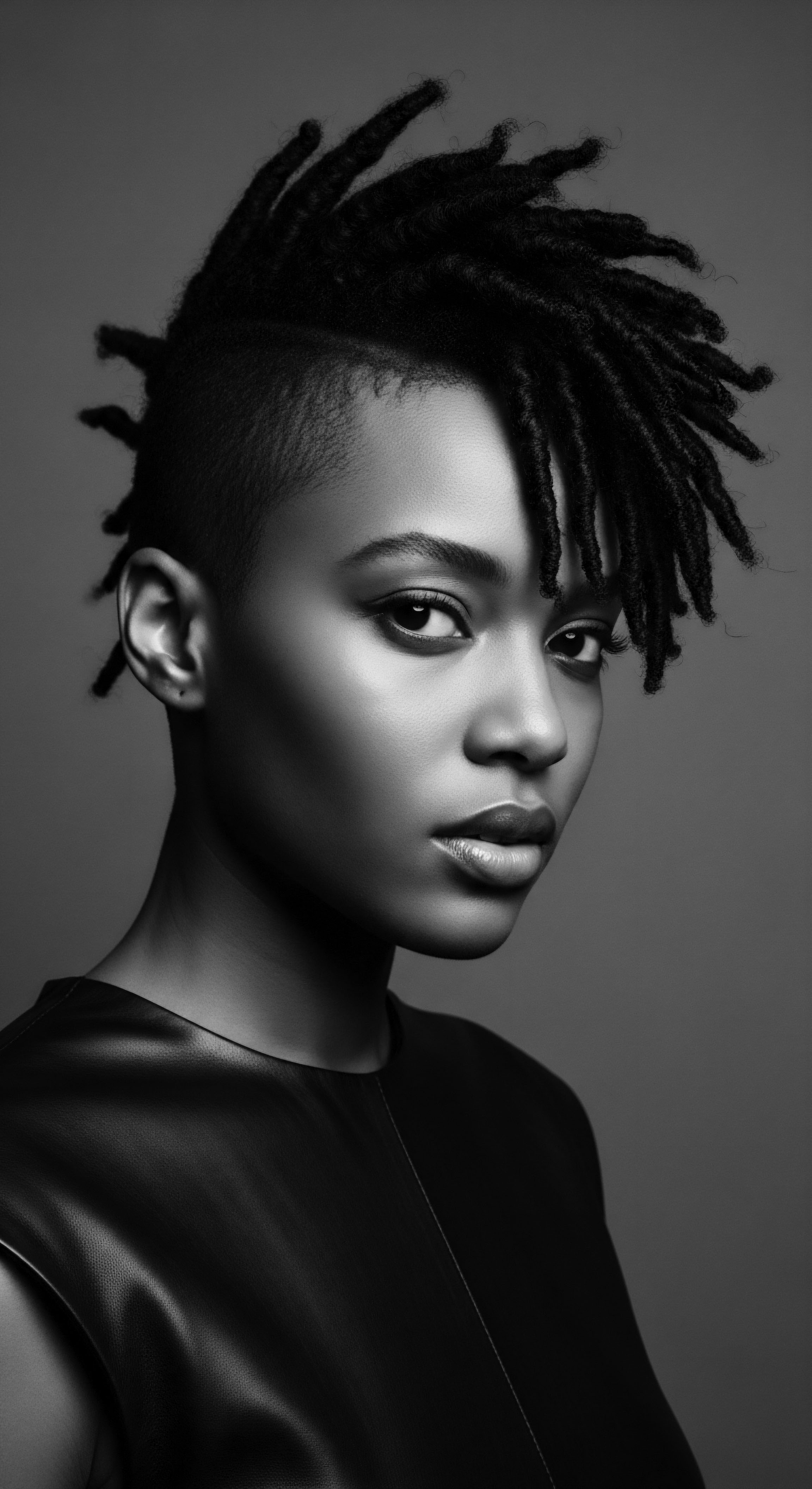
From Hearth to Handheld
The evolution of heat styling tools reflects broader technological and societal changes. Early methods, reliant on direct heat from fire, were often crude and carried risks of burns or hair damage. The invention of the pressing comb, while still requiring external heat, offered greater control.
The advent of electricity brought forth the electric hot comb, followed by blow dryers and flat irons, making heat styling more accessible and efficient. This technological progression has profoundly impacted the cultural meaning of heat styling.
With modern tools, the act of heat styling has become more individualized, often performed alone rather than in communal settings. This shift, while offering convenience, has also altered the social dynamics surrounding the practice. However, it has also democratized access to various styles, allowing for greater experimentation and personal expression.
The cultural meaning now includes the agency to choose, to switch between natural and straightened styles with greater ease, reflecting a fluid and dynamic understanding of Black hair identity. The history of these tools is a chronicle of ingenuity, born from a need to manage and style textured hair in diverse environments, from the rural South to urban centers, always adapting to new technologies while carrying forward the spirit of innovation.

The Delicate Balance of Choice
The relationship between heat styling and hair health is a continuous dialogue within the Black hair community. While heat can offer styling versatility, excessive or improper use can lead to thermal damage, characterized by weakened hair bonds, breakage, and loss of natural curl pattern. This awareness has fueled the natural hair movement, which advocates for embracing and caring for one’s natural texture without reliance on heat or chemical straighteners.
Yet, the cultural meaning of heat styling is not solely defined by this dichotomy. For many, it represents a choice, a part of their diverse styling repertoire. The key lies in understanding the science of heat on hair – the temporary breaking of hydrogen bonds, the potential for permanent damage to disulfide bonds – and applying heat with intention and care.
This scientific understanding, combined with ancestral wisdom about nourishing and protecting hair, allows for a more informed and balanced approach. The ongoing conversation about heat styling reflects a community grappling with historical pressures, celebrating natural beauty, and exercising the freedom to choose how they present their hair to the world, all while prioritizing the health and vitality of their strands.
The journey of self-acceptance and the reclamation of natural texture have redefined the meaning of heat styling for many. It is no longer solely a means of conformity but can be an artistic tool, used sparingly for specific looks, or a temporary departure from natural curls. This shift highlights a deeper cultural understanding ❉ that Black hair, in all its forms, is inherently beautiful and valuable, and styling choices are expressions of personal agency, rooted in a rich and evolving heritage.

Reflection
The journey through the cultural meaning of heat styling in Black hair heritage reveals not a simple answer, but a living, breathing archive of human experience. From the foundational understanding of the hair’s unique biology, passed down through generations of observation and intuitive care, to the intricate rituals that transformed a necessity into a communal act, and finally to the complex relay of identity, politics, and personal choice, heat styling stands as a powerful testament to the enduring spirit of textured hair. It is a story etched in the warmth of a pressing comb, the gentle steam of a traditional treatment, and the bold declaration of a chosen style.
This narrative, steeped in ancestral wisdom and continuously reshaped by contemporary realities, affirms that each strand holds a universe of meaning, a continuous dialogue between the past, the present, and the boundless possibilities of the future. The Soul of a Strand, indeed, pulsates with this rich, evolving heritage, inviting us to honor every twist and turn of its magnificent story.
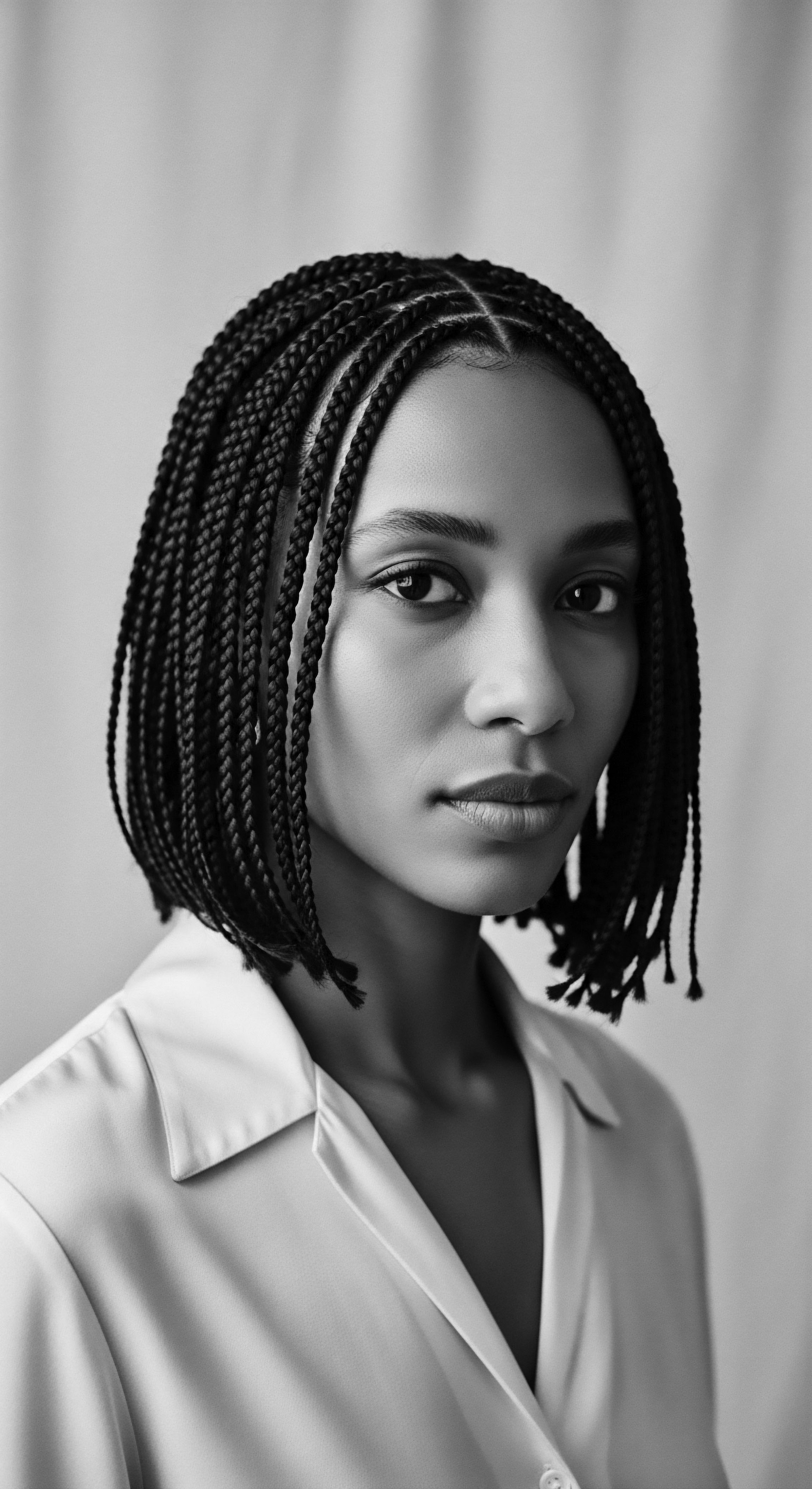
References
- Tharps, L. L. (2001). Hair Story ❉ Untangling the Roots of Black Hair in America. St. Martin’s Press.
- Byrd, A. S. & Tharps, L. L. (2014). Hair Story ❉ Untangling the Roots of Black Hair in America. St. Martin’s Griffin. (Updated Edition)
- Mercer, K. (1994). Welcome to the Jungle ❉ New Positions in Black Cultural Studies. Routledge.
- Banks, I. (2000). Hair Matters ❉ Beauty, Power, and the Politics of African American Women’s Hair. New York University Press.
- Craig, M. L. (2002). Ain’t I a Beauty Queen? ❉ Black Women, Beauty, and the Politics of Race. Oxford University Press.
- Akbar, N. (1998). Light from Ancient Africa. Mind Productions & Associates.
- Rooks, N. M. (1996). Hair Raising ❉ Beauty, Culture, and African American Women. Rutgers University Press.
- Hall, S. (1997). Representation ❉ Cultural Representations and Signifying Practices. Sage Publications.
